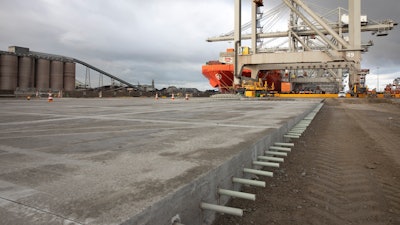Exactly How Composites are Changing the Landscape of Construction Materials
Exactly How Composites are Changing the Landscape of Construction Materials
Blog Article
Opening the Ecological Benefits of Recycled Compounds in Construction and Layout
In the realm of building and layout, the utilization of recycled composites holds substantial pledge for enhancing sustainability practices and decreasing environmental impact (composites). By integrating these cutting-edge products, there is a prospective to deal with crucial issues such as waste minimization, power preservation, and a decrease in carbon footprint. The shift in the direction of an extra lasting future in these sectors depends upon unlocking the full capacity of recycled compounds. This conversation will certainly explore the diverse advantages and obstacles linked with integrating recycled composites into building and style, using a glimpse into the transformative possibilities that lie in advance.

Environmental Impact Reduction
The decrease of ecological effect with the usage of recycled compounds in building and design plays a vital function in sustainable techniques. By integrating recycled composites into building products, the building industry can considerably lower its carbon impact and add to an extra green future. These lasting materials, made from repurposed plastics, timber fibers, or various other recycled elements, supply a sensible option to traditional building and construction products without compromising on top quality or longevity.
Recycled compounds help draw away waste from landfills and lower the requirement for drawing out raw materials, hence saving natural deposits. In addition, the manufacturing procedure of these composites commonly takes in much less energy and sends out fewer greenhouse gases contrasted to creating virgin materials (composites). This shift towards making use of recycled composites not just minimizes ecological injury however additionally promotes a circular economy by urging the reuse of materials that would or else be discarded
Waste Minimization
With a concentrate on reducing waste in building and construction and style, the combination of recycled compounds supplies a sustainable option to reduce environmental effect. Waste reduction is a vital aspect of sustainable practices, and the use of recycled composites provides a possibility to accomplish this objective properly. By using products that have actually already offered their preliminary function, such as recycled plastics or redeemed timber fibers, the construction and layout industries can substantially minimize the amount of waste created and sent out to landfills.
Recycled composites have the potential to draw away considerable amounts of waste from conventional disposal approaches, adding to an extra round economic situation where resources are used effectively. Furthermore, the manufacturing process of recycled composites often consumes less energy and produces less exhausts contrasted to virgin products, additionally decreasing the ecological impact of building and construction and layout jobs.
Carrying out waste minimization techniques through the incorporation of recycled composites not just aids in saving natural resources but additionally advertises a much more sustainable approach to structure and creating for a greener future.
Energy Conservation
Including recycled compounds not just decreases waste in construction and design yet also plays a critical role in enhancing energy conservation practices within the industry. The use of recycled compounds in building and construction can considerably contribute to energy conservation through various methods. By advertising the usage of recycled compounds in construction and design, the industry official source can make substantial strides in the direction of attaining power effectiveness and minimizing its carbon footprint, ultimately adding to an extra lasting developed environment.
Carbon Footprint Decrease
Enhancing sustainability methods with the usage of recycled composites in building and construction and layout considerably reduces the carbon impact of the sector. By integrating recycled materials right into the production of composites, the requirement for virgin resources decreases, leading to reduced power consumption and greenhouse gas emissions connected with traditional production procedures. This reduction in carbon impact is important in combating climate adjustment and advertising a more ecologically friendly approach to building and construction and style.
The carbon footprint decrease achieved with the fostering of recycled compounds aligns with the worldwide press in the direction of sustainable practices and the reduction of commercial exhausts. Ultimately, by prioritizing the combination of recycled compounds, the sector can make significant strides in reducing its carbon footprint and contributing to a much more lasting future.
Lasting Future
The assimilation of recycled composites in building and construction and style not just addresses instant environmental worries linked here but additionally lays a solid structure for a sustainable future in the sector. By integrating recycled compounds right into building products and products, the building and construction and design fields can substantially reduce their dependence on virgin sources, leading to an extra circular economic climate. This change towards sustainability is critical for alleviating the ecological impact of typical building practices, which commonly cause high levels of waste generation and source deficiency.

Conclusion
Finally, recycled compounds supply considerable environmental benefits in building and layout by minimizing ecological impact, minimizing waste, preserving energy, lowering carbon impact, and advertising a lasting future. Embracing making use of recycled compounds can contribute to a more environmentally-friendly technique to building and layout, eventually resulting in a much more lasting and greener future for all.
The reduction of ecological impact via the usage of recycled compounds in construction and style plays a critical function in lasting methods.With an emphasis on lessening waste in building and design, the integration of recycled compounds supplies a sustainable remedy to lower ecological effect. By promoting the usage of recycled composites in construction and style, the industry can make substantial strides towards attaining power effectiveness and reducing its carbon footprint, ultimately contributing to a much more lasting constructed atmosphere.

Report this page